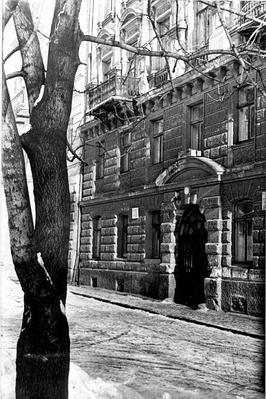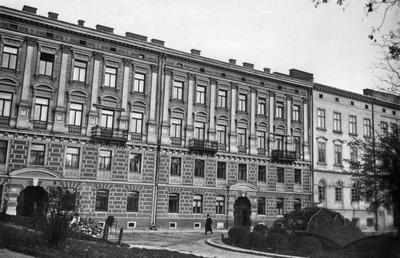Vul. Vynnychenka, 26 – residential building
This residential apartment building was built in 1879-1880 by architect Michał Fechter in Neo-Renaissance style. In 1898-1939 the building was owned by the Shevchenko Scientific Society; in the Soviet period it was adapted for dwelling. It is an architectural monument of local significance (protection number 426).
Architecture
The four-storied townhouse is located in the row housing of the street. It is built of brick and plastered, based on a square plan with a square courtyard. The main façade is designed in Neo-Renaissance style, with magnificent architectural decoration. The façade's composition is based on the symmetry principle: two arched gates accentuate the central axes of, respectively, two seven-axis symmetrical parts. The ground floor and the second floor are rusticated, divided by a cornice and accentuated by a developed massive cornice supported by modillions, where cast metal balconies are arranged, two in each section. The two upper floors are designed according to the order system. They are connected by Corinthian pilasters supporting an entablature with a molded arabesque frieze having attic windows. The rectangular windows are decorated with segmental pediments on the third floor and with linear pediments on the fourth floor; the ground floor windows are segmental. The building is topped with a cornice supported by modillions.
Personalities
Michał Fechter — Lviv architect who designed the four-tiered townhouse where the Shevchenko
Scientific Society was accomodated later
Ivan Franko — Ukrainian writer, poet, publicist,
interpreter, scholar, public and political figure, Doctor of Philosophy, member of the Shevchenko Scientific Society
Leopold Habermann — owner of the real estate 2 4/4 in 1865–1875,
who commissioned a reconstruction of an old two-tiered house
Borys Hrinchenko — Ukrainian writer, pedagogist,
literature historian, ethnographer, historian, publicist, public and culture
figure
Mykhailo Hrushevskyi — history professor, organizer of
Ukrainian science, political figure, publicist, Head of the Central Сouncil of the Ukrainian People's
Republic, Head of the Shevchenko Scientific Society for many years
Jan III Sobieski — Polish king
Stefan Kachala — Greek-Catholic priest, political
and public figure, a Populist (Narodovets),
founder and member of the Shevchenko Scientific Society
Filaret Kolessa — ethnographer, folklorist, composer,
musicologist, literature historian, member of the Shevchenko Scientific Society
and of the All-Ukrainian Academy of Sciences, founder of Ukrainian ethnographic
musicology
Ivan Levynskyi (Jan Lewiński) — Ukrainian architect, pedagogist,
enterpreneur, public figure
Kost Levytskyi — renowned political figure in
Galicia, co-founder of Ukrainian
National-Democratic Party, scientist, founder and head of the National Council
in Lviv, publicist, member of Shevchenko Scientific Society
Yaroslava Muzyka — Ukrainian artist, restorator,
collectioner, public figure, who resided in the building
Yevhen Ozarkevych — doctor, director of the Shevchenko
Scientific Society's Medical Commission, founder of the People's Hospital (Narodna Lichnytsia) in 1903
Pelekhin — professor who donated considerable funds for the Shevchenko Scientific
Society to purchase the building
Włodzimierz Podhorodecki
— architect,
designed a reconstruction project of the building's wing to adapt it to a
printshop
Dorota Sacherl — co-owner of the real estate 2 4/4
Elżbieta Sacherl — owner of the real estate 2 4/4 in 1802–1812
Kasper Sacherl — owner of the real estate 2 4/4 after 1812
Leopold Sacherl — a Lviv merchant, co-owner of the
real estate 2 4/4 before 1865
Jakub Sobieski — Ruthenian voivode, castellan of Krakow, father of the Polish king
Jan III Sobieski, who founded a Discalced Carmelite nuns' convent with a church
of the Meeting of the Lord on the so-called Striletski
hills
Vasyl Stefanyk — Ukrainian writer, public figure,
politician, member of Austrian parliament representative of Galicia, resided in
the building
Kyrylo Studynskyi — Ukrainian philologist, Slavistics
scholar, literature historian, writer, public figure, Doctor of Philosophy,
member of All-Ukrainian
Academy of Sciences and of Shevchenko Scientific Society
Ivan Trush — Ukrainian Impressionist painter,
landscape artist and portraitist, art critique, organizer of artistic life in
Galicia
Lesia Ukrainka — Ukrainian writer, interpreter,
cultural figure, who resided in the building
Mykhailo Vozniak— Ukrainian literature historian and
folklorist, member of Shevchenko Scientific Society, academic of the Academy of
Sciences of Ukrainian SSR
Honorata Wajda — Piotr Wajda's wife, co-owner of
the real estate 2 4/4 in 1875–1898
Piotr Wajda — member of the Lviv City Council in
the construction department, owner of the real estate 2 4/4 in 1875–1898
Jakub Walker — Lviv cartwright, owner of the real
estate 2 4/4 in 1786–1802
Organizations
Sources
1. State Archive of Lviv Oblast (DALO), item
2/2/3456
2. Central State Historical Archives of Ukraine
in Lviv (CDIAL), item 186/8/829
3. Володимир Вуйцик, "До історії будинків
Наукового Товариства ім. Шевченка. Вулиця В. Винниченка, 26", LeopolitanaII, (Львів: Класика, 2013), 212-215.
4. Іван Крип’якевич, Історичні проходи по Львову (Львів: Каменяр, 1991).
5. Лінда Світлана, "Архітектура історизму (40–90-і роки XIX ст.)", Архітектура
Львова. Час і стилі XIII–XXI ст. (Львів: Центр Європи, 2008), 341-343.
Media Archive Materials
Related Pictures













